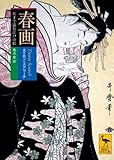Alex Moshakis “Is Nobuyoshi Araki's photography art or porn?” http://www.guardian.co.uk/artanddesign/2013/may/08/nobuyoshi-araki-photography-art-porn
倫敦のMichael Hoppen Galleryで、荒木経惟展が開かれている*1。 またそれと同時にTaschenから3巻本の写真集Bondageも刊行されている*2。
この記事で言及されているのはアラーキー*3の作品を巡る2つの問題。つまりアートとポルノとの境界の問題、そしてアラーキーの作品と〈日本文化の伝統〉との関係について。これらの問いに答えるために(比較対象として)持ち出されるのは浮世絵(「春画」)である。ちょっと長いけれど、抜き書きしておく;
British Museumは今年中に大々的な春画展を行うのか。そういえば、英国は世界的な春画研究家のタイモン・スクリーチ氏の母国なのだった。スクリーチ氏については『春画 片手で読む江戸の絵』をマークしておくとして、アラーキーは日本の春画が「全部見せない(don't show everything)」ことを強調している。これについては、中野美代子先生の比較研究を参照すべきだろう(『中国春画論序説』)。つまり、春画と衣裳との関係は、中国:全裸、日本:着衣、印度:全裸+アクセサリーということになる*7。
(…) First, where does the line between art and pornography fall? And second, how much of Araki's work is part of a bigger Japanese tradition? In an attempt to answer both, Hoppen has offset the photographer's work with a small selection of original shunga, Japanese woodblock prints widely distributed between the 17th and 20th centuries. Exquisitely crafted and often brightly coloured, these feature kimono-wearing couples performing physically improbable sexual acts: half-dressed on the living-room floor, masturbating concurrently in lavish bedrooms, carrying on beneath a mess of robes, all with their genitals enlarged. "They're highly explicit," Hoppen says. "Much more explicit than Araki's work, but because hundreds of years have passed since they were made, they've become artefacts rather than simply pornographic drawings."Shunga*4 became popular in the 1600s, a sexually charged extension of ukiyo-e, a genre of woodblock art that depicted a utopian Japanese lifestyle. First distributed in the country's major cities to a wealthy elite, rapid developments in printing technology brought shunga to a burgeoning middle class, who enjoyed both the fantastical sexual imagery and the typically humorous conversations printed alongside. As demand grew, so did production. "Each book would typically include two or three volumes," says Tim Clark, head of the Japanese section at the British Museum, which will hold an extensive exhibition of shunga in October. "Each volume would contain a set of dozens of images. We're talking about thousands and thousands of printed images."
Books were produced by some of the best-known ukiyo-e artists of the day (Hokusai*5 and Utamaro*6, among others), who created sexual adventure for a mainstream audience neither afraid nor embarrassed to embrace erotic imagery. But was it art? "Absolutely so," says Clark. "But you've got to bear in mind that in the west we've come up with this notion that art and pornography are separate, that there's an absolute firewall between the two. Shunga is a profoundly different equation – it's both explicit sexually and very sophisticated artistically. That's an equation in pre-modern times we weren't really used to."
Shunga was banned in 1722, then again some 70 years later and once more in the 1840s – but government enforcement was lax, and book production continued until the early 20th century. By that point, Japan, previously isolated from the rest of the world, had opened its borders to foreign travellers, most of whom were surprised by the public prevalence of such explicit imagery. Perhaps embarrassed, authorities made moves to suppress any manifestation of Japanese culture that failed to tally with late 19th-century western notions of propriety, prompting shunga's sudden decline. It remained taboo in public and in academia until 1990 – only a couple of years before Araki offended those Austrian guards.
Araki has long been a fan of the art form. "I'd like to take photos similar to shunga," he once said, "but I haven't reached that level yet. There is bashfulness in shunga. The genitals are visible, but the rest is hidden by the kimono. In other words, they don't show everything. They are hiding a secret." Araki works along the fault lines of Japanese culture – between the public and the private, the civilised and the seedy. His work is popular (or offensive, depending on how you see it) in the west for the frisson of excitement it draws from those unfamiliar with Japanese cultural practice. But in Japan it chimes for its honesty. "It's about the double standard associated with Japanese culture," says Simon Baker, curator of photography at the Tate. "It's an incredibly polite, formal society on the surface, [but it] has this hidden underside of sexuality. Araki very effectively works on this relationship."

- 作者: タイモン・スクリーチ,高山宏
- 出版社/メーカー: 講談社
- 発売日: 2010/07/12
- メディア: 文庫
- 購入: 1人 クリック: 16回
- この商品を含むブログ (8件) を見る

- 作者: 中野美代子
- 出版社/メーカー: 講談社
- 発売日: 2010/08/10
- メディア: 文庫
- クリック: 447回
- この商品を含むブログ (14件) を見る
1992年に荒木経惟がオーストリアで写真展を開催したとき、美術館の女性警備員が職務をボイコットするということがあったんだね。
*1:http://www.michaelhoppengallery.com/exhibition,current,3,0,0,2318,169,0,0,0,michael_hoppen_gallery.html
*2:http://www.taschen.com/pages/en/community/events/2349.nobuyoshi_araki_b_w_bondage.htm
*3:See also http://d.hatena.ne.jp/sumita-m/20060610/1149962157 http://d.hatena.ne.jp/sumita-m/20060610/1149966101 http://d.hatena.ne.jp/sumita-m/20060927/1159328407 http://d.hatena.ne.jp/sumita-m/20070417/1176782623 http://d.hatena.ne.jp/sumita-m/20080623/1214195486 http://d.hatena.ne.jp/sumita-m/20081124/1227487885 http://d.hatena.ne.jp/sumita-m/20091221/1261419322 http://d.hatena.ne.jp/sumita-m/20100319/1268995947 http://d.hatena.ne.jp/sumita-m/20100819/1282195952
*4:http://www.ukiyoe-gallery.com/gallery9.htm
*5:葛飾北斎。http://25.media.tumblr.com/tumblr_lpop5toZ6V1qc2hrno1_500.jpg
*6:喜多川歌麿。http://www.ohmigallery.com/DB/Images/Shunga/Shunga-004-01-20-2007-8213-x800.jpg
*7:See also http://d.hatena.ne.jp/sumita-m/20110718/1311009859 http://d.hatena.ne.jp/sumita-m/20110826/1314328053